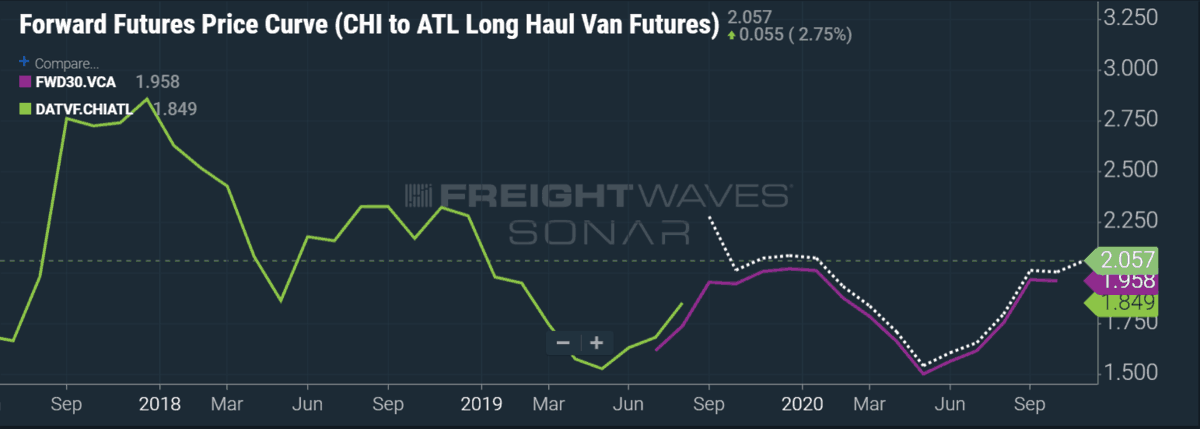The spread between most freight brokers’ cost and what they charge to customers has significantly narrowed, potentially compressing gross margins as peak season nears.
In the first quarter of 2019, trucking spot rates plunged while contract or paper rates sagged slightly, blowing out the spread between the two. By late spring, trucking capacity on the spot market was much less expensive than the rates charged by contracted carriers, and shippers exploited the opportunity.
Shippers dumped their freight onto spot market load boards, searching for the bottom of the market. Freight brokers we spoke to said that they weren’t getting the contracted volumes they had been promised, and then saw the same lanes posted on load boards. That prompted awkward conversations with their customers and hasty rebids for freight that had already been awarded.
National average paper rates dropped further, while spot rates climbed from their low in May. In four months, the spread was cut in half on a percentage basis. And it’s worth reviewing exactly how the relationship between the paper and spot markets played out over the past year.
A year ago, in September 2018, the national average spot rate excluding fuel was $1.80/mile, while contract was at $2.05/mile, according to DAT’s RateView tool. Spot was 12.1% under the paper rate. From last fall, both rates moved downward, but spot fell faster. By May, spot was at $1.47/mile and the paper rate was at $1.93/mile, a 23.8% spread.
Since May, the rates have converged. Paper rates fell 8 cents a mile to $1.85/mile this month, while spot rates climbed to $1.59/mile, a spread of just 14%.
Why does this matter? It matters because the spread between spot and paper rates determines where volume and capacity goes. If spot is meaningfully higher than the paper rate, capacity will abandon contracted freight and look for opportunities on the spot market. If spot is meaningfully lower than the paper rate, shippers will pull freight from contracted carriers and put it on the spot market.
In fact, new research from our Freight Intel Group has quantified the magnitude and duration the spread needs to be before it alters shipper and carrier behavior: about 15% for at least a month. Shippers who responded to our survey said that they moved about 30% of their freight from contracted carriers to the spot market in response to low spot rates.
Because spot is inherently more volatile than the contract market — it’s composed of many thousands of negotiations that happen every day — it serves as a leading indicator not only of contract rates but also of shipper and carrier behavior. It tells carriers and brokers how to think about their bids on contract freight if they want them to hold up for any amount of time.
In a different survey, carriers and brokers said that their contracted agreements with shippers were being renegotiated about every three months. Contract rates, never rock-solid to begin with, have truly devolved into paper rates.
While freight markets have become more transparent over the past few years, allowing shippers, carriers and brokers to reach consensus about freight conditions more quickly, shippers tend to respond more slowly to volatility than other market participants. Part of the reason for shippers’ delayed reaction is that spot rates always move ahead of paper rates, but part of it is that they have limited visibility and only possess information about the lanes important to their business.
That’s how the current situation — a narrow spread between paper and spot rates — developed: Contract rates have continued to sag downward and have not responded to the recent surge in spot rates.
Sentiment on the Chicago-to-Atlanta lane continues to improve as freight futures traders place higher bids on September and October contracts (FWD.VCA). Compared to 30 days ago (FWD30.VCA), the entire curve has moved incrementally upward as we get closer to peak season.

What makes this situation especially dangerous for freight brokers, as opposed to trucking carriers, is that it’s harder for a broker to walk away from contract freight that is priced lower than the prevailing spot rates. A carrier might plausibly say it doesn’t have capacity in the area, but it’s a broker’s job to find capacity no matter what the market looks like.
Freight brokers need to communicate with customers who value their relationship and warn them about rising trucking costs. Paper rates need to be marked to market, and in this case, we’re nearing the point where they need to come up in order to secure capacity for what everyone expects to be a robust retail season.










